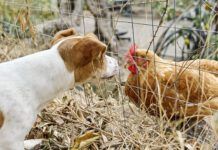Is There a “Plan B” for Dogs?
No. While Alizin can terminate an early pregnancy in dogs, it is not available in the United States.
Hydrotherapy for Dogs
Water therapy for dogs can help with weight loss and recovery from orthopedic injuries and surgical procedures. It’s usually used as part of a larger dog physical therapy treatment plan to get your dog feeling their best as quickly as possible.
Caring for Dogs with Disabilities
It can take a village to care for a special needs pet. When Catherine Prystup from Texas offered to foster Kanuk, a dog who could not use his back legs, she relied on the "Team Kanuk" approach.
MSM for Dogs
MSM is methylsulfonylmethane, a naturally occurring compound of sulfur, carbon, and oxygen it is is included in most dog arthritis supplements for good reason. It works and has research backing up its use.
Does My Dog Need Electrolytes?
Humans and dogs have different needs for hydration and electrolyte balance. Most healthy dogs do not require added electrolytes in their diet under normal circumstances. Understanding how dogs regulate their hydration and when electrolyte supplementation is truly needed can help you make informed decisions, especially during times of illness or extreme exertion.
Adequan for Dogs
Adequan is an injectable medication for the treatment of osteoarthritis in dogs. It is a disease-modifying osteoarthritis drug (DMOAD), meaning it can reverse some of the damage that occurs in arthritic joints.
Nystagmus in Dogs
If your dog’s eyes are rapidly moving, seeming uncontrolled, your dog may be suffering from nystagmus. It’s usually part of vestibular disease, which is common in older dogs.
Is That a Hot Spot on My Dog?
Hot spots are localized areas of inflammation and infection of the skin. These raw, inflamed, and sometimes oozing lesions can appear suddenly and worsen quickly if left untreated.
Can Dogs Get Bird Flu?
Bird flu is making the news a lot lately, and you may wonder if dogs can catch bird flu. Also called avian flu or referred to as H5N1, this virus has the potential to expand its horizons beyond birds to humans and other mammals. As of this writing, no dogs have become clinically ill or died from this recent strain of H5N1 bird flu.
Gastropexy in Dogs
What is gastropexy? Gastropexy is a surgical procedure done to “tack” or attach the stomach to the body wall, so it can’t flip or twist. Bloat—a dangerous condition technically called “gastric dilatation and volvulus (GVD)”—is when the dog’s stomach fills with gas and twists. It is life-threatening. If the stomach flips, the odds of a good outcome go down dramatically.
How to Get Rid of Nasal Mites in Dogs
Nasal mites in dogs are unusual mites that can be responsible for sneezing, difficulty breathing, and other hard to diagnose respiratory problems.
Using Behavior Modification to Address Compulsive Licking, Chewing, and Scratching in Dogs
Excessive self-licking and chewing can be caused by a medical issue. It can also be a behavioral problem, a classic example of an obsessive/compulsive disorder. Either way, it's annoying to the dog's human companion, and dangerous to the health of the dog. Here are tips for dealing with dogs who self-lick and chew excessively. To begin behavior modification, determine your dog's stressors and start eliminating them. Make a list of everything?you can think that is stresses your dog even just a little bit, even if the stressors don't seem directly related to the licking. Your list might include thunder, small children, dogs on television, cats, riding in cars, visits to the vet, shock collars, medical issues, and many more. Most owners can identify between 10 and 20 stressors for their dogs.


















